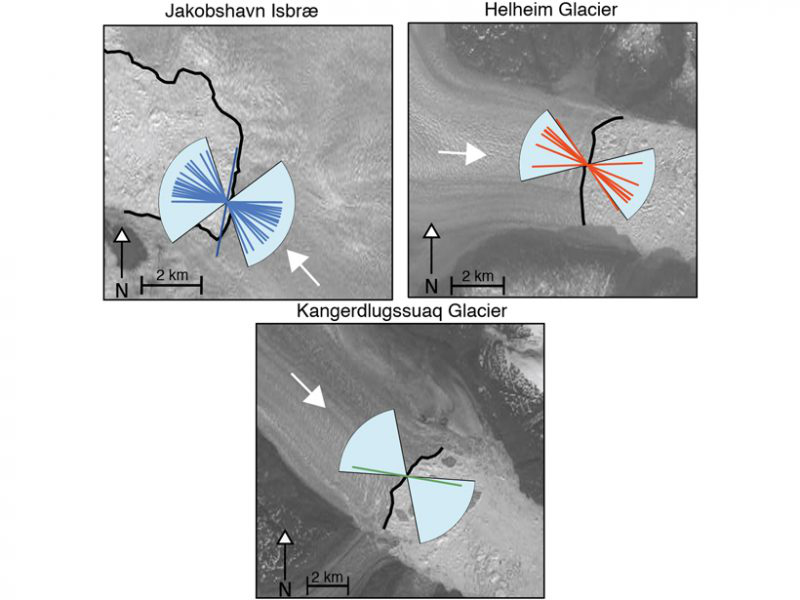Small Seismic Signals Tell a Story of Iceberg Calving
Seismic signals detected hundreds of kilometers away from Greenland glaciers reveal the calving style and iceberg size.
SOURCE: Journal of Geophysical Research: Earth Surface

The three glaciers investigated in this study flow in the direction of the white arrow and terminate at the black line in each panel. 95% of all glacial earthquakes at each glacier have force-azimuth orientations within the blue wedges; the colored line segments show force orientations for the seismic events measured in this study. Credit: Olsen and Nettles [2019], Figure 7
As they detach from the terminus of a glacier, many large icebergs generate seismic signals detected hundreds of kilometers away by a global network of seismometers. About 50 glacial earthquakes, caused by the calving of gigaton-sized icebergs, currently occur in Greenland each year.
Olsen and Nettles [2019] use new methods to analyze seismic records produced by icebergs calved from three of Greenland’s largest glaciers. They find that additional seismogenic calving events, too small for detection using standard methods and distant recordings, occur before half of the previously known glacial earthquakes, and after one third of such earthquakes.
Combining analysis of seismic data and of terminus imagery, the authors show that the smaller events are caused by the same calving mechanism that produces large glacial earthquakes—the capsize of icebergs caused by buoyancy forces, and not subaerial ice-cliff failure, as suggested by the “marine ice-cliff instability” hypothesis.
The results of this analysis demonstrate that calving often occurs in discrete sequences of iceberg loss, with approximately 10 to 30 percent more ice lost through buoyancy-driven calving than previously recognized. The authors present the first empirical demonstration of a relationship between seismic magnitude and iceberg size. These new findings advance understanding of the physics of iceberg calving and increase the utility of seismic data as a remote-sensing tool to investigate glaciers and ice-sheet mass loss.
Citation: Olsen, K. G., & Nettles, M. [2019]. Constraints on terminus dynamics at Greenland glaciers from small glacial earthquakes. Journal of Geophysical Research: Earth Surface, 124. https://doi.org/10.1029/2019JF005054
—Olga Sergienko, Associate Editor, JGR: Earth Surface
最新国外工作学习机会
1. Executive Director of Alabama Water Institute
Tuscaloosa, Alabama
Commensurate with experience
The University of Alabama - Office for Research & Economic Development
2. Assistant Professor of Geology
Middlebury, Vermont
Middlebury College
https://findajob.agu.org/job/8010920/assistant-professor-of-geology/
3. Bruce D. Benson Endowed Chair in Petroleum Geology
Boulder, Colorado
Negotiable
University of Colorado- Boulder
4. Dean, Graduate School of Oceanography
Kingston, Rhode Island
University of Rhode Island
https://findajob.agu.org/job/8010927/dean-graduate-school-of-oceanography/



